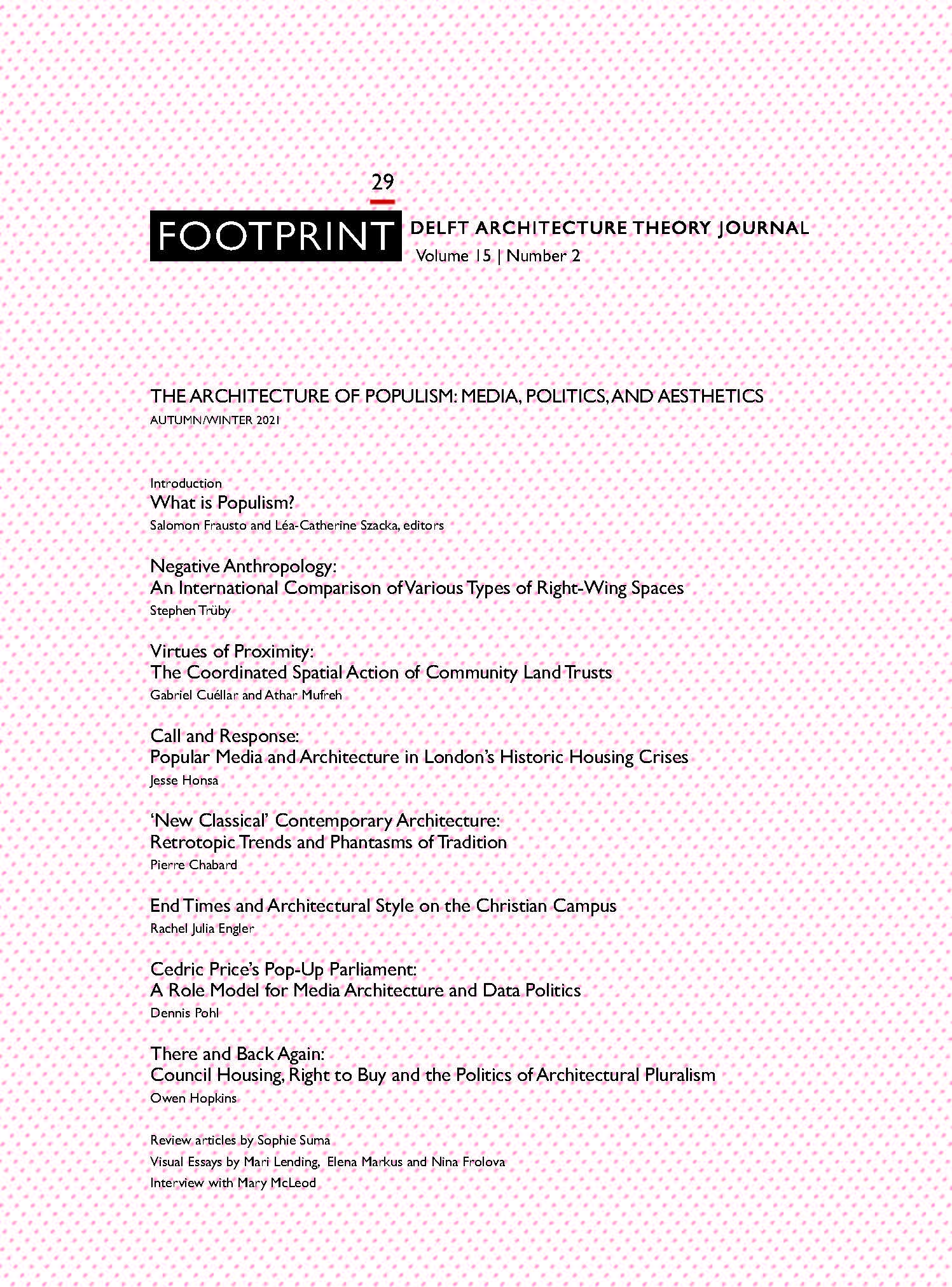Cedric Price’s Pop-Up Parliament
A Role Model for Media Architecture and Data Politics
DOI:
https://doi.org/10.7480/footprint.15.2.6115Abstract
The digital era has supposedly had a drastic impact on contemporary forms of political debate. Live-tweets, podcasts, and posts have become the main channels for politics, polemics, and populism alike. But these tendencies are not only an acceleration of the politics of media brought about by the logics behind television, cybernetics, and computation in the post-war era. They gained strength when populist politics appropriated information access via mass media, which once promised the emancipation of ordinary citizens by architectural means through pop-culture.
In this essay I seek to elaborate how Cedric Price’s 1965 design of the Pop-Up Parliament dealt with a media-technical condition of politics, while proposing that architecture was an integral part of the media network of governing. Price’s project is paradigmatic of the 1960s, a period when the media operations of information compression, prediction, and audience targeting became more decisive for politics than the content of debate. This analysis allows us, on the one hand, to problematise conventional definitions of populism towards a media-based concept, and on the other, to further our understanding of architecture as a political medium operating directly with media such as documents, television, and computers. This essay argues that the advent of digital media calls for a different architectural history of populism, one which engages with the operativity of media and cultural techniques, rather than relying upon the symbolic representation of ideology in architecture.
References
Baldwin-Philippi, Jessica, ‘The Technological Performance of Populism’, New Media & Society 21, no. 2 (February 2019): 376–97.
Banham, Reyner, Paul Barker, Peter Hall and Cedric Price, ‘Non-Plan: An Experiment in Freedom’,
New Society 13, no. 338 (20 March 1969).
Banham, Reyner, Theory and Design in the First Machine Age, 2nd edition (New York: Praeger Publishers, 1967).
Barker, Peter, ‘Non-Plan Revisited: Or the Real Way Cities Grow: The Tenth Reyner Banham
Memorial Lecture’, Journal of Design History 12, no. 2 (1999): 95–110.
Cockerell, Michael, Live from Number 10: The Inside Story of Prime Ministers and Television (London: Faber, 1988).
Hansard, ‘House of Commons Rebuilding’, Parliamentary Debates: House of Commons, vol. 393, (28 October 1943) columns 403–473.
Heatherington, Alastair, Kay Weaver, and Michael Ryle, The Study for the Hansard Society on the Televising of the House of Commons (London: Hansard Society for Parliamentary Government, 1990).
Herdt, Tanja, ‘Die Stadt und die Architektur des Wandels: Projekte und Konzepte des britischen
Architekten Cedric Price (1960–ca. 1984)’, PhD Dissertation (ETH Zurich, 2012).
Hogg, Quintin (Lord Hailsham), House of Commons Debates (1965) vol. 713, column 1065, 28 May, a motion by T. L. Iremonger to introduce an experiment in television broadcasting, as cited in Bob Franklin, ‘Televising the British House of Commons: Issues and Developments’, in Televising Democracies, ed. Bob Franklin (London/New York: Routledge, 1992), 10.
Lewis, B. N., ‘Fun Palace: Counterblast to Boredom’, New Society no. 133 (15 April 1965): 8.
Sharr, Adam and Stephen Thornton, Demolishing Whitehall: Leslie Martin, Harold Wilson and the
Architecture of White Heat (London: Routledge, 2013).
‘Potteries Thinkbelt’, New Society no. 192 (2 June 1966): 74.
Pohl, Dennis, ‘Simultan Regieren: Sprache und Schrift im Europäischen Ministerrat’, Archiv für Mediengeschichte 19, Kleine Formen, ed. Joseph Vogl, Friedrich Balke, and Bernhard Siegert (2021): 157–169.
Price, Cedric, ‘The Pop-Up Parliament’, New Society no. 148 (29 July 1965): 8.
Price, Cedric , Introduction, Architectural Design (What about Learning?) (May 1968), 242.
Price, Cedric, ‘Developing Patterns of Urbanisation: Learning’, Transactions of the Bartlett Society 7 (1968), 55–73.
McLuhan, Marshall, Understanding Media: The Extensions of Man (Cambridge, MA: MIT Press, 1994 [1964]).
Mouffe, Tanja, For a Left Populism (London: Verso Books, 2018).
Scott, Mark, ‘Cambridge Analytica Did Work for Brexit Groups, Says Ex-Staffer’, Politico, 30 July 2019.
Stanley, J. Mathews, ‘An Architecture for the New Britain: The Social Vision of Cedric Price’s Fun Palace and Potteries Thinkbelt’, PhD Dissertation (Columbia University, 2003), 298–313.
Stener Jørgensen, Nina, ‘Capital of Feedback’, Footprint 13, no. 2 (December 2019): 25–46.
Vismann, Cornelia, Files: Law and Media Technology, trans. Geoffrey Winthrop-Young (Stanford: Stanford University Press, 2008).
Downloads
Published
Issue
Section
License
Copyright (c) 2022 Dennis Pohl

This work is licensed under a Creative Commons Attribution 4.0 International License.
- Authors retain copyright and grant the journal right of first publication with the work simultaneously licensed under a Creative Commons Attribution License that allows others to share the work with an acknowledgement of the work's authorship and initial publication in this journal.
- Authors are able to enter into separate, additional contractual arrangements for the non-exclusive distribution of the journal's published version of the work (e.g., post it to an institutional repository or publish it in a book), with an acknowledgement of its initial publication in this journal.





